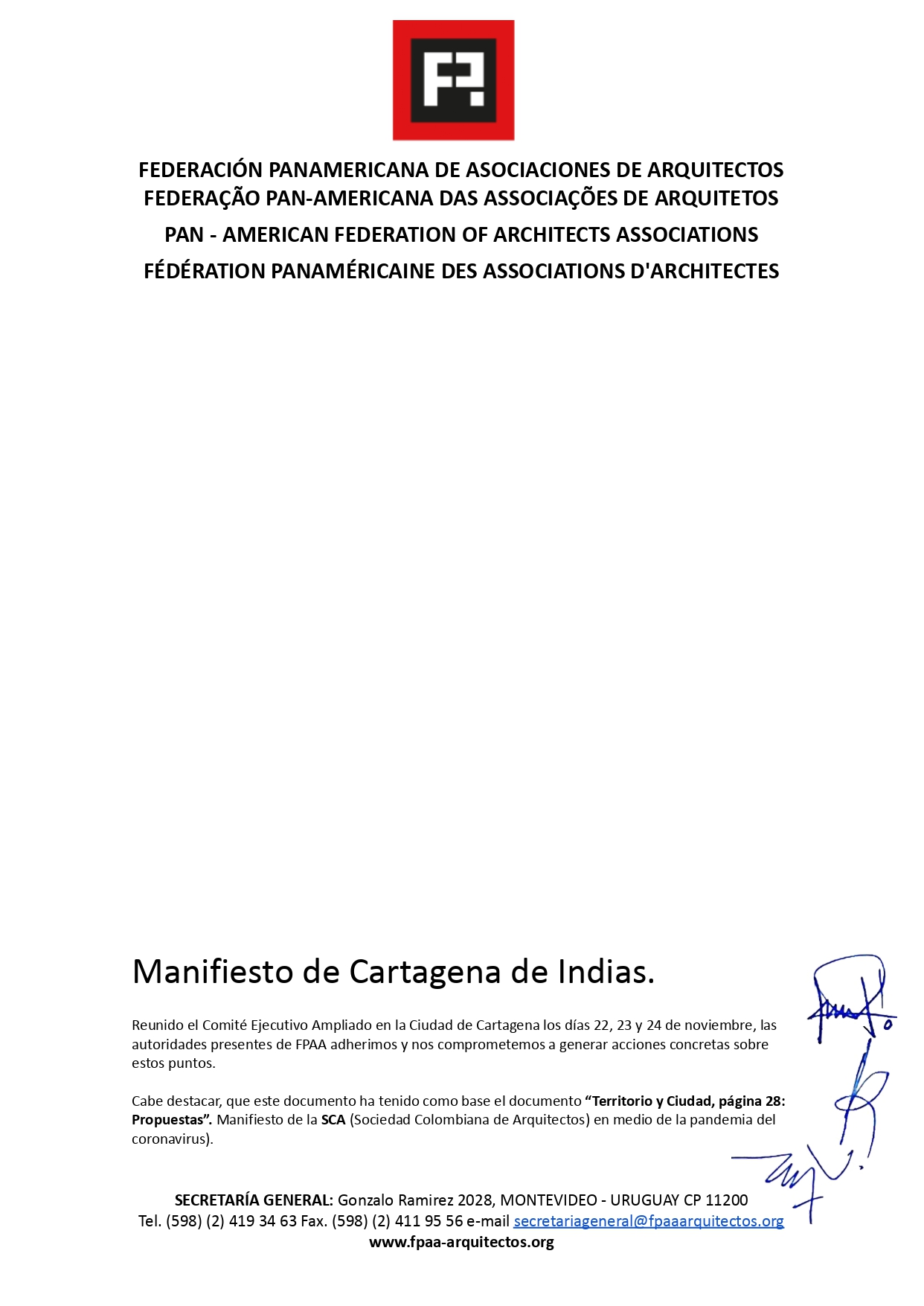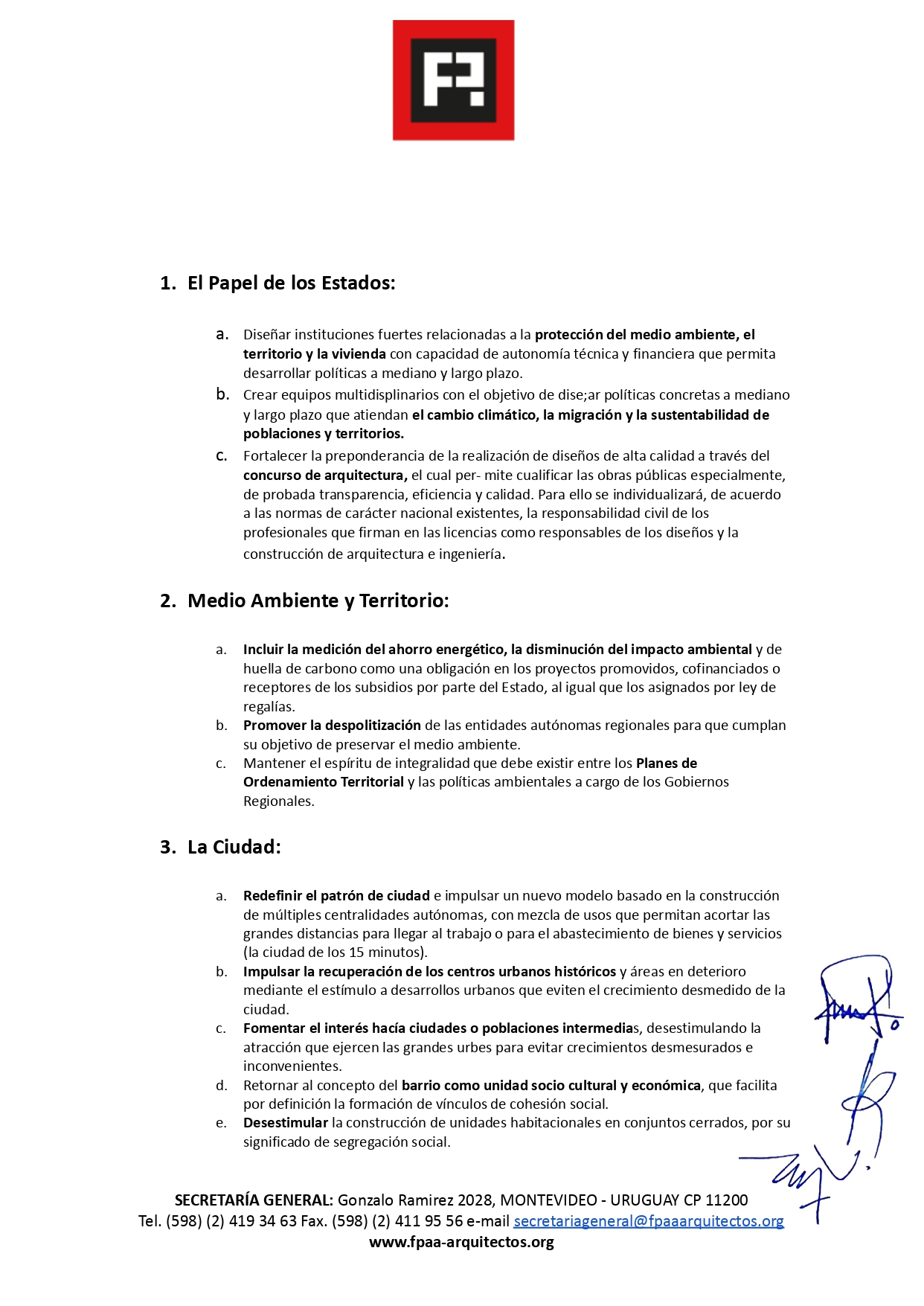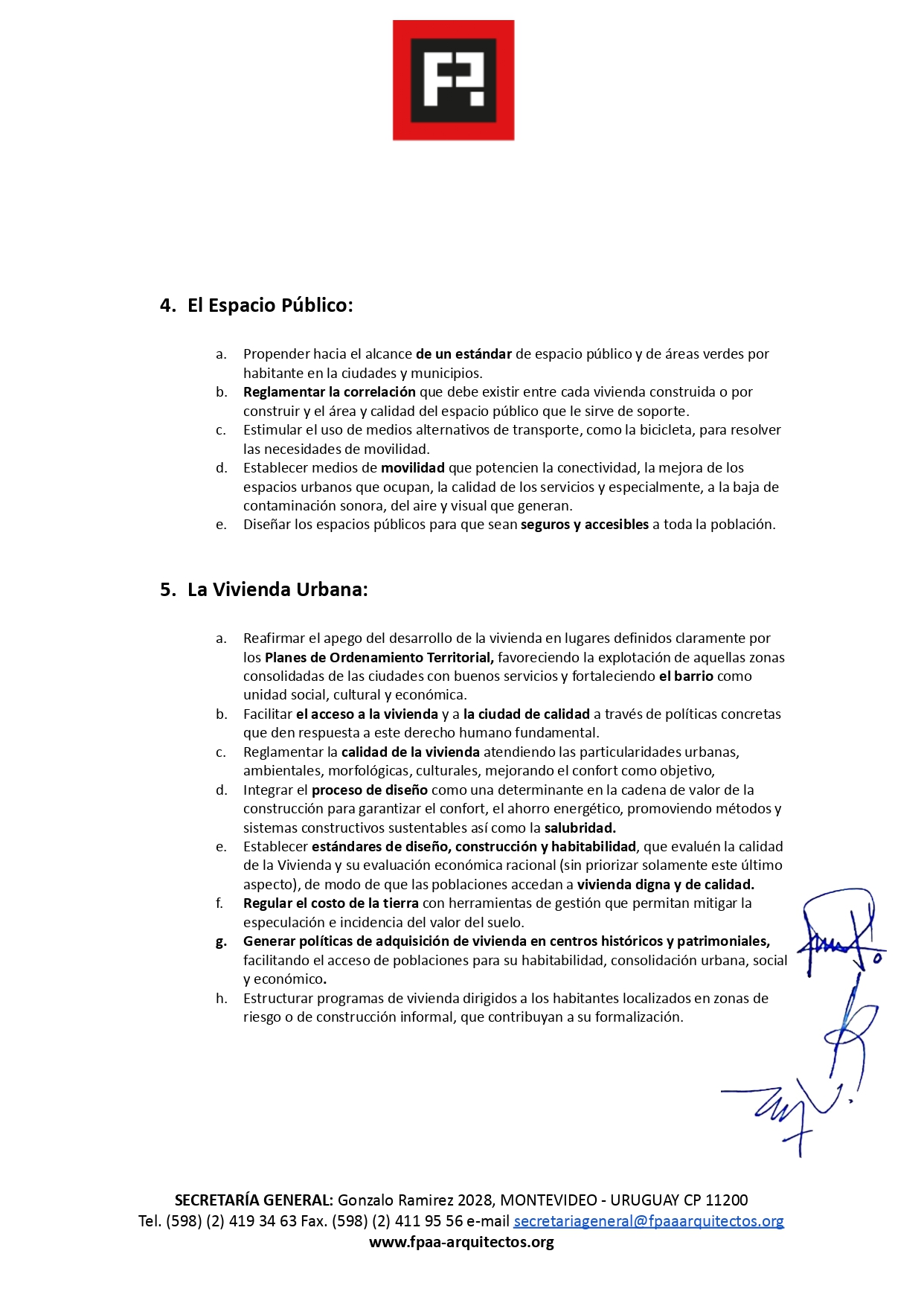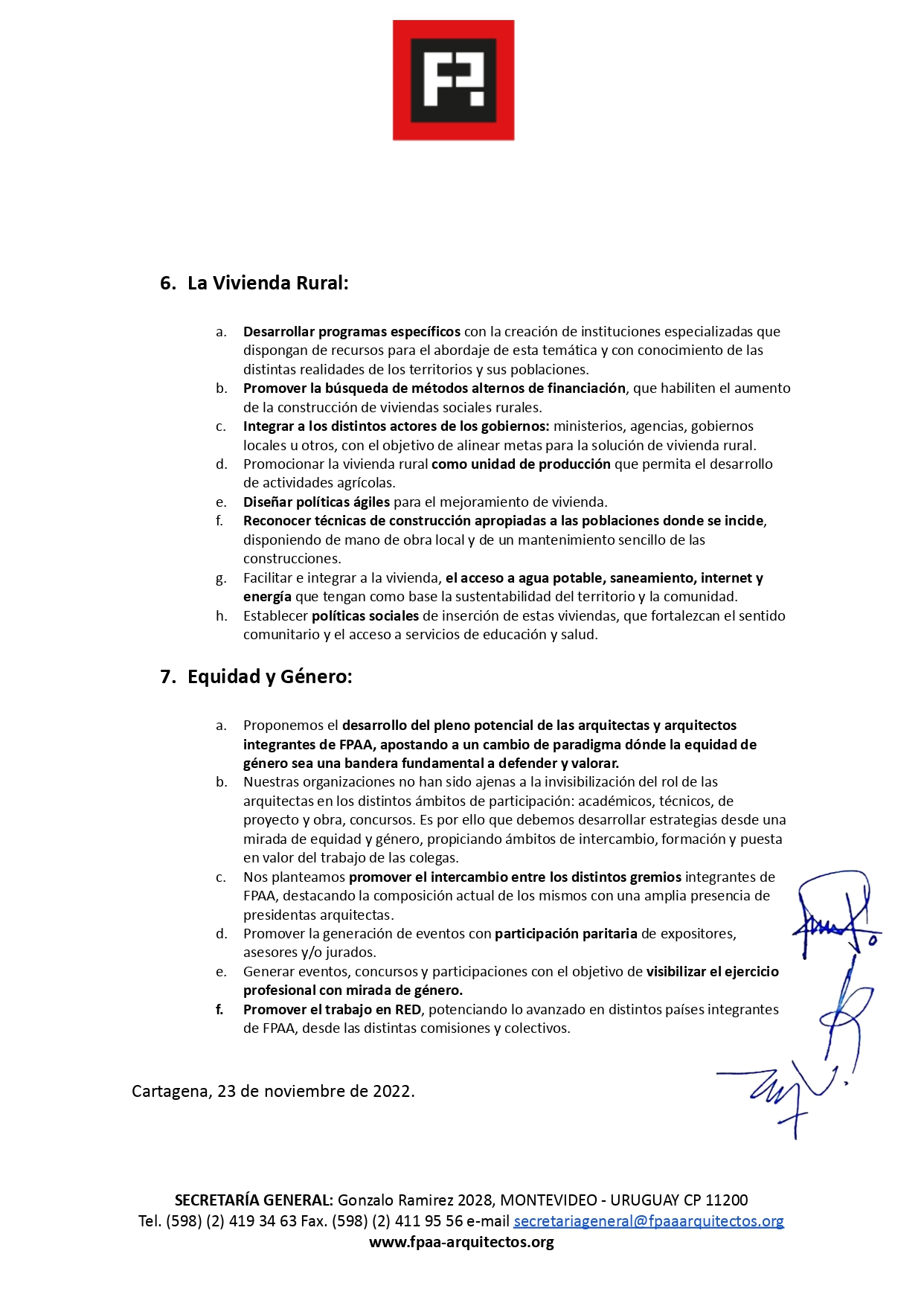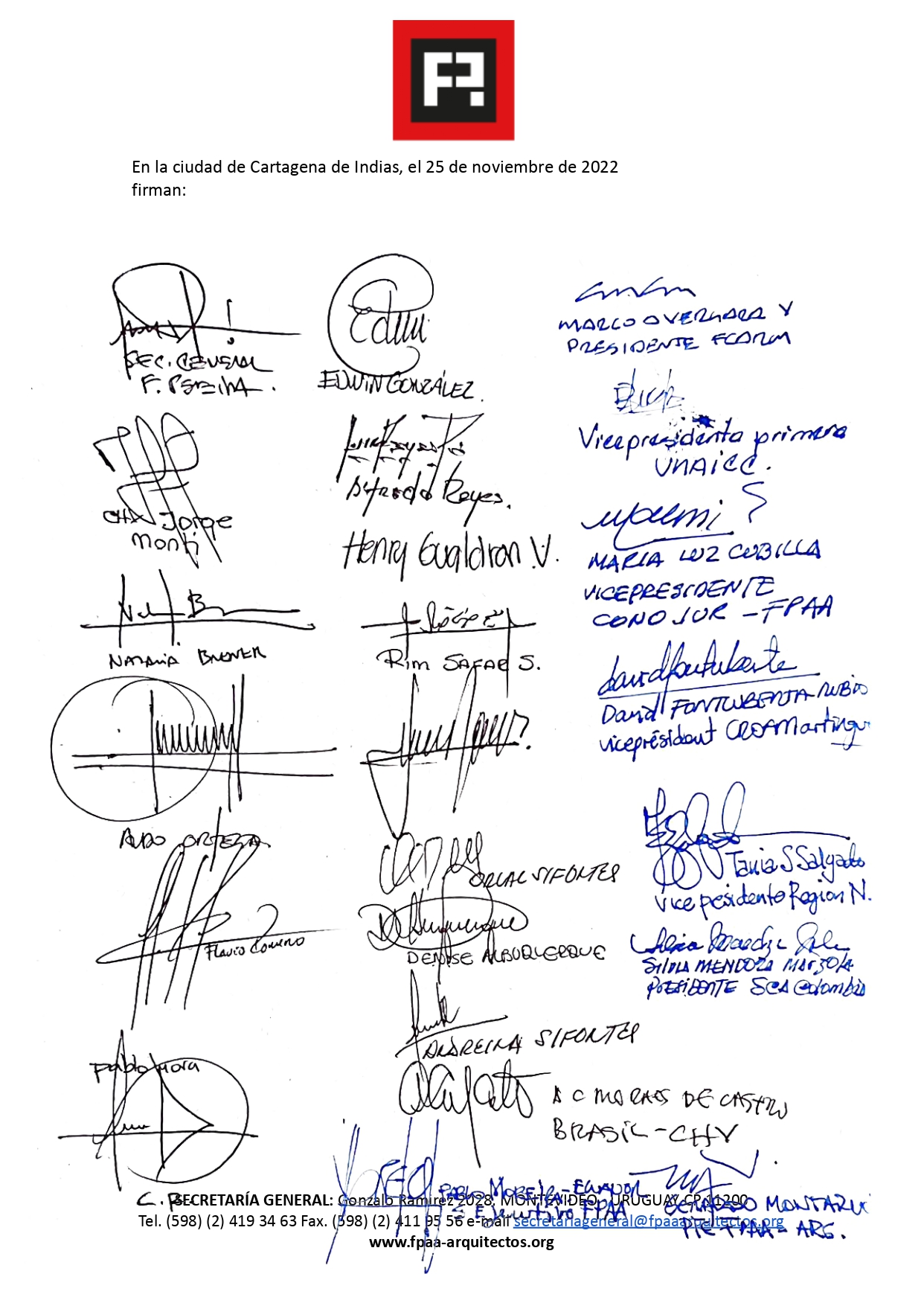Para acceder a la Carta Declaratoria firmada en la ciudad de Cartagena por autoridades y miembros de FPPA hacer click aquí
Manifiesto Cartagena
Manifiesto de Cartagena de Indias.
Reunido el Comité Ejecutivo Ampliado en la Ciudad de Cartagena los días 22, 23 y 24 de noviembre, las autoridades presentes de FPAA adherimos y nos comprometemos a generar acciones concretas sobre estos puntos.
Cabe destacar, que este documento ha tenido como base el documento “Territorio y Ciudad, página 28: Propuestas”. Manifiesto de la SCA (Sociedad Colombiana de Arquitectos) en medio de la pandemia del coronavirus).
El Papel de los Estados:
1- Diseñar instituciones fuertes relacionadas a la protección del medio ambiente, el territorio y la vivienda con capacidad de autonomía técnica y financiera que permita desarrollar políticas a mediano y largo plazo.
2- Crear equipos multidisciplinarios con el objetivo de diseñar políticas concretas a mediano y largo plazo que atiendan el cambio climático, la migración y la sustentabilidad de poblaciones y territorios.
3- Fortalecer la preponderancia de la realización de diseños de alta calidad a través del concurso de arquitectura, el cual per- mite cualificar las obras públicas especialmente, de probada transparencia, eficiencia y calidad. Para ello se individualizará, de acuerdo a las normas de carácter nacional existentes, la responsabilidad civil de los profesionales que firman en las licencias como responsables de los diseños y la construcción de arquitectura e ingeniería.
Medio Ambiente y Territorio:
1- Incluir la medición del ahorro energético, la disminución del impacto ambiental y de huella de carbono como una obligación en los proyectos promovidos, cofinanciados o receptores de los subsidios por parte del Estado, al igual que los asignados por ley de regalías.
2- Promover la despolitización de las entidades autónomas regionales para que cumplan su objetivo de preservar el medio ambiente.
3- Mantener el espíritu de integralidad que debe existir entre los Planes de Ordenamiento Territorial y las políticas ambientales a cargo de los Gobiernos Regionales.
La Ciudad:
1- Redefinir el patrón de ciudad e impulsar un nuevo modelo basado en la construcción de múltiples centralidades autónomas, con mezcla de usos que permitan acortar las grandes distancias para llegar al trabajo o para el abastecimiento de bienes y servicios (la ciudad de los 15 minutos).
2- Impulsar la recuperación de los centros urbanos históricos y áreas en deterioro mediante el estímulo a desarrollos urbanos que eviten el crecimiento desmedido de la ciudad.
3- Fomentar el interés hacía ciudades o poblaciones intermedias, desestimulando la atracción que ejercen las grandes urbes para evitar crecimientos desmesurados e inconvenientes.
El Espacio Público:
1- Propender hacia el alcance de un estándar de espacio público y de áreas verdes por habitante en la ciudades y municipios.
2- Reglamentar la correlación que debe existir entre cada vivienda construida o por construir y el área y calidad del espacio público que le sirve de soporte.
3- Estimular el uso de medios alternativos de transporte, como la bicicleta, para resolver las necesidades de movilidad. Establecer medios de movilidad que potencien la conectividad, la mejora de los espacios urbanos que ocupan, la calidad de los servicios y especialmente, a la baja de contaminación sonora, del aire y visual que generan.
4- Diseñar los espacios públicos para que sean seguros y accesibles a toda la población.
La Vivienda Urbana:
1- Reafirmar el apego del desarrollo de la vivienda en lugares definidos claramente por los Planes de Ordenamiento Territorial, favoreciendo la explotación de aquellas zonas consolidadas de las ciudades con buenos servicios y fortaleciendo el barrio como unidad social, cultural y económica.
2- Facilitar el acceso a la vivienda y a la ciudad de calidad a través de políticas concretas que den respuesta a este derecho humano fundamental.
3- Reglamentar la calidad de la vivienda atendiendo las particularidades urbanas, ambientales, morfológicas, culturales, mejorando el confort como objetivo, Integrar el proceso de diseño como una determinante en la cadena de valor de la construcción para garantizar el confort, el ahorro energético, promoviendo métodos y sistemas constructivos sustentables así como la salubridad.
4- Establecer estándares de diseño, construcción y habitabilidad, que evalúen la calidad de la Vivienda y su evaluación económica racional (sin priorizar solamente este último aspecto), de modo de que las poblaciones accedan a vivienda digna y de calidad.
5- Regular el costo de la tierra con herramientas de gestión que permitan mitigar la especulación e incidencia del valor del suelo.
6- Generar políticas de adquisición de vivienda en centros históricos y patrimoniales, facilitando el acceso de poblaciones para su habitabilidad, consolidación urbana, social y económico.
7- Estructurar programas de vivienda dirigidos a los habitantes localizados en zonas de riesgo o de construcción informal, que contribuyan a su formalización.
La Vivienda Rural:
1- Desarrollar programas específicos con la creación de instituciones especializadas que dispongan de recursos para el abordaje de esta temática y con conocimiento de las distintas realidades de los territorios y sus poblaciones.
2- Promover la búsqueda de métodos alternos de financiación, que habiliten el aumento de la construcción de viviendas sociales rurales.
3- Integrar a los distintos actores de los gobiernos: ministerios, agencias, gobiernos locales u otros, con el objetivo de alinear metas para la solución de vivienda rural.
4- Promocionar la vivienda rural como unidad de producción que permita el desarrollo de actividades agrícolas.
5- Diseñar políticas ágiles para el mejoramiento de vivienda.
6- Reconocer técnicas de construcción apropiadas a las poblaciones donde se incide, disponiendo de mano de obra local y de un mantenimiento sencillo de las construcciones.
7- Facilitar e integrar a la vivienda, el acceso a agua potable, saneamiento, internet y energía que tengan como base la sustentabilidad del territorio y la comunidad.
8- Establecer políticas sociales de inserción de estas viviendas, que fortalezcan el sentido comunitario y el acceso a servicios de educación y salud.
Equidad y Género:
1- Proponemos el desarrollo del pleno potencial de las arquitectas y arquitectos integrantes de FPAA, apostando a un cambio de paradigma dónde la equidad de género sea una bandera fundamental a defender y valorar.
2- Nuestras organizaciones no han sido ajenas a la invisibilización del rol de las arquitectas en los distintos ámbitos de participación: académicos, técnicos, de proyecto y obra, concursos. Es por ello que debemos desarrollar estrategias desde una mirada de equidad y género, propiciando ámbitos de intercambio, formación y puesta en valor del trabajo de las colegas.
3- Nos planteamos promover el intercambio entre los distintos gremios integrantes de FPAA, destacando la composición actual de los mismos con una amplia presencia de presidentas arquitectas.
4- Promover la generación de eventos con participación paritaria de expositores, asesores y/o jurados.
5- Generar eventos, concursos y participaciones con el objetivo de visibilizar el ejercicio profesional con mirada de género.
6- Promover el trabajo en RED, potenciando lo avanzado en distintos países integrantes de FPAA, desde las distintas comisiones y colectivos.
Cartagena, 23 de noviembre de 2022.





